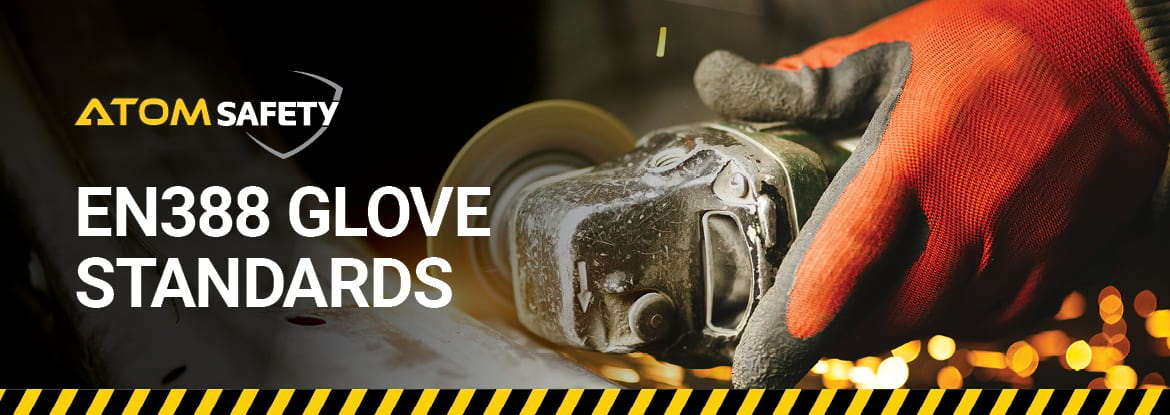What is the EN 388 Glove Standard for?
EN 388 is a European safety standard for gloves providing hand protection against mechanical risks. Even though the EN388 standard is not an Australian Standard, since its inception, it has become the benchmark in performance ratings for the glove manufacturing and safety industry. This standard involves six specific tests that are designed to assess the performance of a glove and its fabric/layers.
How do you read the EN 388 numbers on safety gloves?
Specific test methods, markings, and information must be supplied in order for gloves to comply with EN388. This includes information on the risk of:
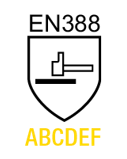
|
|
This is displayed on the glove with the pictogram above. The ABCDEF will indicate the performance levels of the glove for each risk indicator. The higher the number or letters, the greater the protection level. The standard is only applicable if the gloves meet at least level 1 or level A for at least one of the EN388 protective categories.
What is the difference between EN 388:2016 and EN 388:2003?
In 2016, EN388:2003 received some important updates to become the new glove standard, EN388:2016. The updated standard includes two new additional tests for gloves to pass. Glove performance, technology and materials have dramatically improved over the past several years, causing cut resistance innovations to continually surface, and, as a result, require more accurate and precise testing. Therefore, the EN388 standard was updated to help improve cut score transparency and performance to ensure workers can make informed decisions about the safety gloves they select. Glove manufacturers were given until the end of 2021 to comply with the new standards. Therefore, if gloves have the EN388:2003 pictograms with only four indicators, they are no longer compliant.
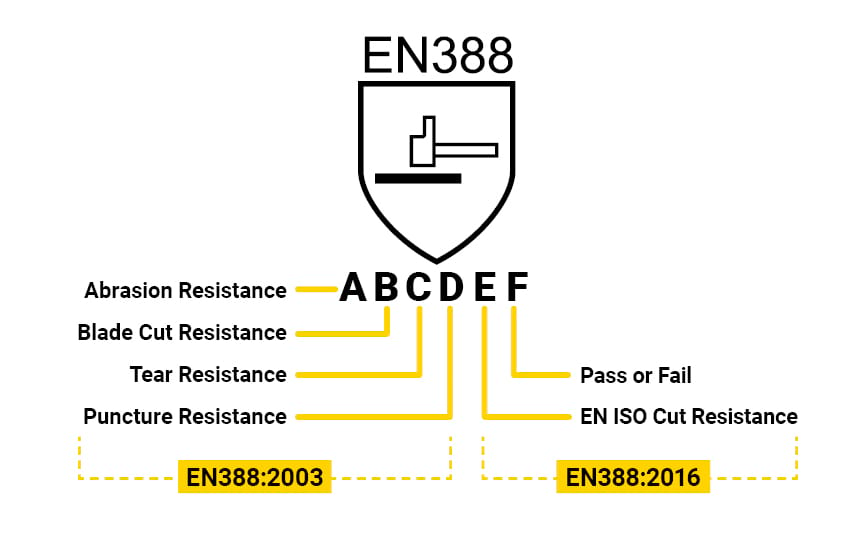
EN388:2003 Testing Procedures
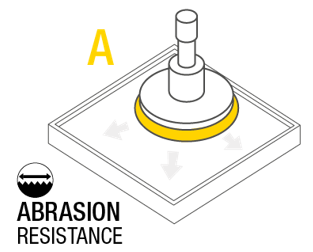 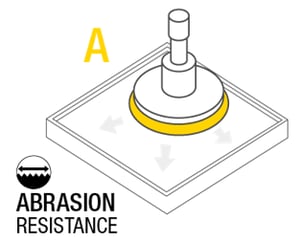
|
A = Abrasion Resistance TestA glove’s abrasion resistance refers to how many times it can withstand abrasive pressure from sandpaper. Measured in revolutions, a glove with low abrasive resistance may only survive 100 revolutions (level 1), whereas a glove with high abrasive resistance can withstand over 8,000 (level 4). Abrasion resistance is especially important for handling rough materials such as bricks. The level of abrasion resistance is indicated with a number between 1 and 4. |
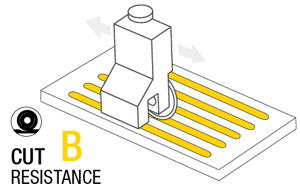
|
B = Circular Blade Cut Resistance (Coupe Test)The Coupe Test is completed with a specific weight (5 Newtons) and a circular blade that will run back and forth until it cuts through the glove. The Coupe Test is rated from 1-5. However, gloves that test beyond level 3 or produce a false Coupe Test reading will receive an "X", and the ISO Cut Test will be used to provide the glove cut level. Gloves with a high blade cut resistance are ideal for working with potentially sharp materials such as sheet metals and glass. |
.png?width=300&height=368&name=EN388%20(2).png) |
C = Tear Resistance TestTear resistance is measured in Newtons with a tensile strength machine, using pre-cut palm material from four glove samples. The material is fitted into the jaws of the machine, with the tear resistance being measured as the jaws move apart at a constant rate of speed (100mm/min). The force needed to tear the material serves as a benchmark. Gloves with a high tear resistance withstand greater pressure and tougher working conditions. The level of tear resistance is indicated with a number between 1 and 4. |
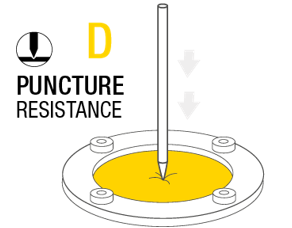 |
D = Puncture Resistance TestPuncture resistance is measured using a round stylus - similar to that of a roofing nail rather than a needle. This is pushed 50mm at a consistent speed of 100mm/min by a compression test machine. Level 1 is the lowest puncture resistance level a glove can receive and Level 4 is the highest. |
EN388:2016 Additional Testing Procedures
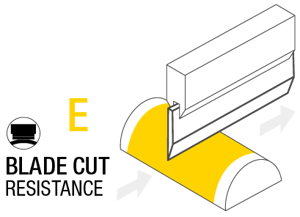
|
E = EN ISO Cut Resistance TestThe ISO Cut Resistance Test is performed with a straight blade that runs over a piece of material once, similar to that of a Stanley knife being run over a piece of material. The key difference is the varied pressure that is applied, with the lowest level of pressure being 2 Newtons (204g) up to 30 Newtons (3,059g). The ISO Cut Resistance is rated A (lowest) - F (highest). Low-level cut-rating gloves are suitable for regular parts assembly and material handling. High-level ratings should be used wherever potentially sharp objects are handled. |
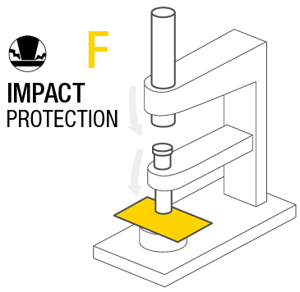
|
F = Impact Protection TestThe Impact Test is a new addition to the EN388 standard, focusing on impact protection on the back of the hand. To test, the glove is struck with 2.5kg at an impact energy of 5J. To pass the glove must transmit a maximum force of 7.0kN. This test is either a Pass (P) or a Fail (F). Gloves with impact protection protect the hand from crushing, pinching and impact from above. These are usually identified by their durable outer shell, made up of solid rubbery material. |
EN388 Performance Levels
|
Test Property |
Performance Levels |
||||
1 |
2 |
3 |
4 |
5 |
|
Abrasion Resistance (Number of Cycles) |
100 | 500 | 2000 | 8000 | - |
Circular Blade Cut Resistance (Index) |
1.2 | 2.5 | 5.0 | 10.0 | 20.0 |
Tear Resistance (Newtons) |
10 | 25 | 50 | 75 | - |
Puncture Resistance (Newtons) |
20 | 60 | 100 | 150 | - |
Test Property |
Performance Levels |
|||||
| A | B | C | D | E | F | |
Straight Blade Cut Resistance (Newtons) |
2 | 5 | 10 | 15 | 22 | 30 |
Test Property |
Performance Levels |
|
| Pass | Fail | |
Impact Protection Test |
>7.0kN | <7.0kN |
Glove Markings
To comply with EN388 requirements, the performance level of the gloves must be shown below the mechanical shield pictogram and printed on both the packaging and each glove. The pictogram should only be used if the glove meets at least level 1 or level A for at minimum one of the EN388 protective categories. You may see an X used instead of a number where a glove has not met a performance level of at least 1. If this occurs on the Circular Blade Cut Resistance Test then they won't have an EN ISO Cut Resistance rating. An X will also be used to rate Circular Blade Cut Resistance when a superior cut rating (ISO Cut Resistance) has been achieved.
Other Notable European (EN) Glove Standards
Additional European glove standards include EN420 - General Requirements for Protective Gloves, EN374 - Protection Against Chemicals and/or Microorganisms, EN407 - Heat Resistant Gloves, EN511 - Protection Against Cold, and EN421 - Protection Against Ionising Radiation and Radioactive Contamination.
Unsure if the gloves you are using provide the best cut-resistant protection. Contact the ATOM Safety team for more information as to which safety gloves are the right fit for you.
